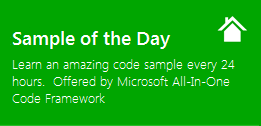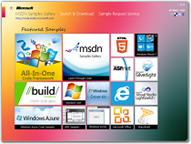[Sample of May 17th] Display time on ASP.NET server side
 |
 |
|
 |
 |
|
Sample Downloads: https://code.msdn.microsoft.com/CSASPNETServerClock-23c659d4
Today’s sample illustrates how to get the time of the server side and show it to the client page. Sometimes a website need to show an unified clock on pages to all the visitors. However, if we use JavaScript to handle this target, the time will be different from each client. So we need the server to return the server time and refresh the clock per second via AJAX.
 You can find more code samples that demonstrate the most typical programming scenarios by using Microsoft All-In-One Code Framework Sample Browser or Sample Browser Visual Studio extension. They give you the flexibility to search samples, download samples on demand, manage the downloaded samples in a centralized place, and automatically be notified about sample updates. If it is the first time that you hear about Microsoft All-In-One Code Framework, please watch the introduction video on Microsoft Showcase, or read the introduction on our homepage https://1code.codeplex.com/.
You can find more code samples that demonstrate the most typical programming scenarios by using Microsoft All-In-One Code Framework Sample Browser or Sample Browser Visual Studio extension. They give you the flexibility to search samples, download samples on demand, manage the downloaded samples in a centralized place, and automatically be notified about sample updates. If it is the first time that you hear about Microsoft All-In-One Code Framework, please watch the introduction video on Microsoft Showcase, or read the introduction on our homepage https://1code.codeplex.com/.
Introduction
The sample illustrates how to get the time of the server side and show it to the client page. Sometimes a website need to show an unified clock on pages to all the visitors. However, if we use JavaScript to handle this target, the time will be different from each client. So we need the server to return the server time and refresh the clock per second via AJAX.
Running the Sample
It is better to demo this sample with two computers. One is as the client side and the other is working as the server side.
Step1: Publish this sample site to one of the computers to make the other one can visit it from the browser.
Step2: Open the browser to view the Default.aspx page from the computer as the client side. You will find there is a clock on the page which displays the time.
Step3: Change the time of the client side computer. And open the browser to view the Default.aspx page again. You can find that the time on the page is different from the clock of the computer itself. This shows that the time there is not based on the client side's time, but the time from the server side.
Using the Code
Step1: Create a C# ASP.NET Empty Web Application in Visual Studio 2010.
Step2: Add a new ASP.NET page to the application and named it as Clock.aspx. Write the code below to it Page_Load event.
protected void Page_Load(object sender, EventArgs e)
{
Response.Expires = -1;
Response.Write(DateTime.Now.ToString());
}
Step3: Add a Default.aspx ASP.NET page to the application. Design the HTML code as follows.
<form id="form1" runat="server">
<div>
The server time is now:<span id="time" />
</div>
</form>
Step4: Add the JavaScript function to get the time from the server side.
function doing() {
var xmlHttp;
try {
xmlHttp = new XMLHttpRequest();
}
catch (e) {
try {
xmlHttp = new ActiveXObject("Msxml2.XMLHTTP");
}
catch (e) {
try {
xmlHttp = new ActiveXObject("Microsoft.XMLHTTP");
}
catch (e) {
alert("Error");
return false;
}
}
}
xmlHttp.onreadystatechange = function () {
if (xmlHttp.readyState == 4) {
var strResult = xmlHttp.responseText;
document.getElementById("time").innerText = strResult;
}
}
xmlHttp.open("GET", "Clock.aspx", true);
xmlHttp.send(null);
}
function gettingTime() {
setInterval(doing, 1000);
}
Step5: Set the onload event of the body element to call the function doing() function.
More Information
# MSDN: Calling Web Services from Client Script
https://msdn.microsoft.com/en-us/library/bb398995.aspx